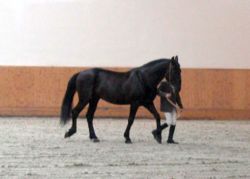Kladruber
N/A
Sat, 19th July, 2025 - 2:53 am GMT
Sponsor Ads:

Alternative Name
N/ABasic Info
It originally came in a variety of colors, including palomino and appaloosa, although today the breed is strictly gray or black, due to a breeding program requiring 18 white and 18 black stallions for various ceremonies of the court.
Health
N/AHabitat
N/ABehavior
Today's horses are usually gray. The animals are large (16.2-17 hh), and primarily used as draft or combined driving horses, where their calm nature, endurance, and speed makes them successful at the international level. The Kladruber is also occassionally outcrossed with lighter breeds to produce a more suitable riding horse, usually for dressage. Kladrubers should be built for strength, with wide, oval hindquarters, a long, muscular neck, and a wide, deep chest. The back is usually slightly long, and the shoulder should be a bit upright, to facilitate higher knee action. The horse is convex in profile, and the legs have strong joints, although they may possess slightly long pasterns. The mane and tail should be thick, and set on a swan-like neck. The horse should have cadenced and elastic movement with high action.Origin
CzechoslovackiaHistory
The Kladruber is the oldest czech horse breed, bred in Kladruby nad Labem national stud, and although it is approching 400 years old, it is remarkably rare (90 mares as of 1995). Kladruby stud was founded in 1579 by Rudolf II as an Imperial stud, at the Perlstein stables. The breed was based on imported Spanish (such as the Andalusian) and Italian horses, crossed with Neapolitan, Danish, Holstein, Irish, and Oldenburg blood, in addition to the heavy Czech breeds. The animal was first developed to be a galakarosier; a heavy type of carriage horse used to pull the imperial coach, usually in a four- or six-in-hand, at ceremonies and funeralsCommon Foods
grassSponsor Ads:
Don't stop think about tomorrow. Don't stop it will soon be here. -- Song I heard on the radio - (Yesterday's gone?)
Kladruber
Coded by: BGID® | ALL RIGHTS RESERVED Copyright © 2000-2025
Disclaimer | Privacy | Report Errors / Contact | Credits
















